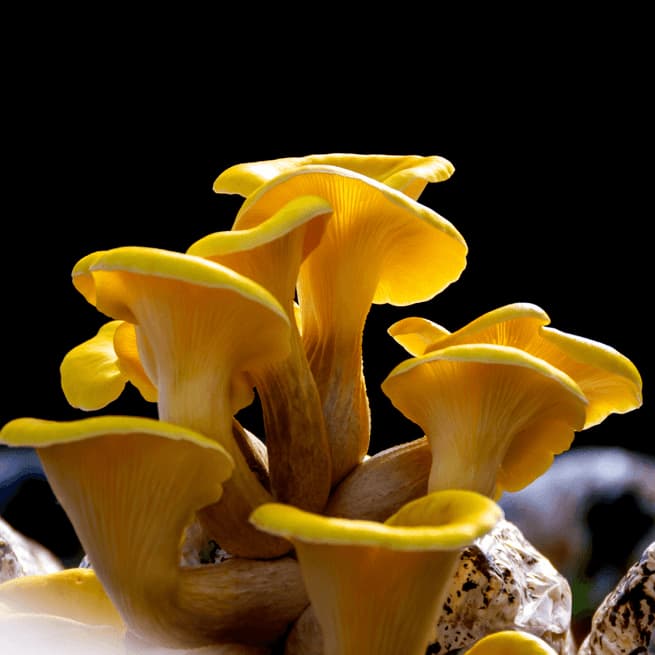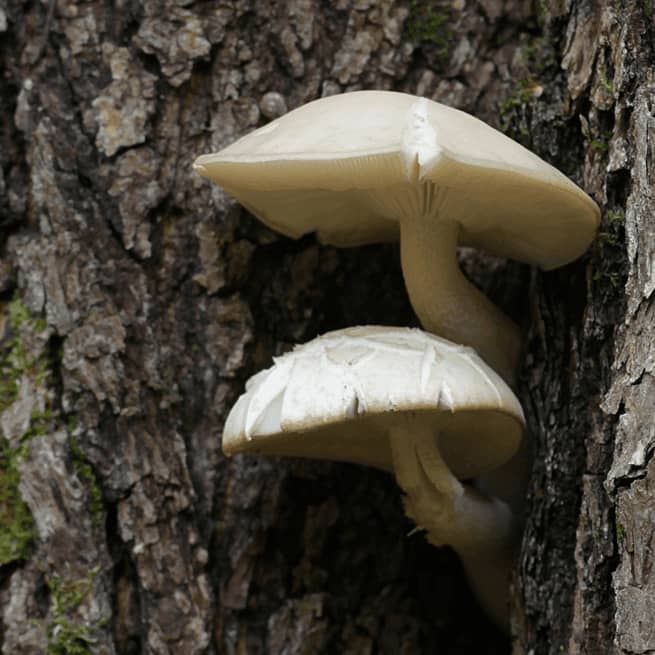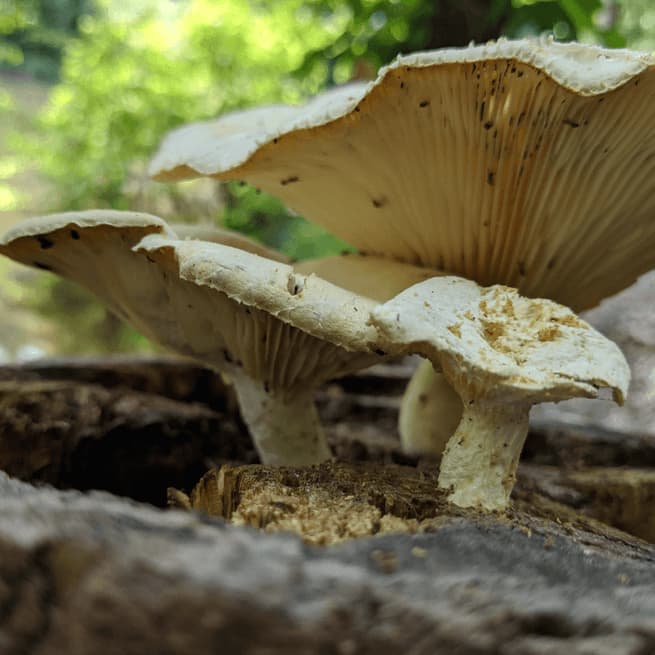

If you’re a big mushroom fan, chances are you’ve heard of the strange, beautiful, and tasty oyster mushroom. With so many types of mushrooms out there, you may be wondering what makes these fungi friends stand out from your traditional button mushrooms. We’ll break down the characteristics of oyster mushrooms in case you want to try them out the next time you see them at your local grocery store.
A quick look at oyster mushrooms
- Taste: briny, anise, rich, earthy
- Shape: curved fan-shaped cap with gills on the underside that extend to stem
- Smell: similar to spices like anise and licorice
- Color: comes in a variety of colors like blue, beige, yellow, pink
- Location: dead trees and rotting wood, common to Europe, Asia, and the Pacific Northwest
The traits of oyster mushrooms
Oyster mushrooms, scientifically known as Pleurotus ostreatus, are a type of edible mushroom native to Europe, Asia, and Africa (although you can find them growing in many places in the United States Pacific Northwest).
What they look like
While you may associate mushroom anatomy with a smooth cap atop a long stem, oyster mushrooms have “gills” that extend and cover their stem. This wavy texture gives them a similar appearance to oysters – hence their name.
Oyster mushrooms come in various colors and have a fan-like or ear-like shape. Formal cultivation of the oyster mushroom began in the early 1900s and was used by German soldiers as food during WW1.
How they grow
Oyster mushrooms are saprotrophs, which means they get their nutrients, or “food,” from dead and decaying matter. For this reason, wild oyster mushrooms primarily grow on rotting wood and trees.
What they taste like
Because of their meaty flavor and chewy texture, oyster mushrooms are commonly used in cooking as meat replacements and additions to recipes like stir-fry, stews, and pasta. They are also often described as having a seafood-like flavor with a rich “briny” depth, which is why they are a popular cooking ingredient.
Each type of oyster mushroom has its unique flavor and is a must-try for all mushroom lovers!
The benefits of oyster mushrooms
Oyster mushrooms are considered functional mushrooms because of their incredible health benefits. Taking these mushrooms as supplements has even been associated with lowering cholesterol and regulating blood sugar.
The types of oyster mushrooms
There are so many different types of oyster mushrooms, each with a unique coloring, taste, and uses! Here are some of the most common ones that you’ll find.
Pink oyster mushrooms

- Color: Beautiful bright pink (which is why they are sometimes called flamingo mushrooms)
- Size: 1-2 inches
- Taste: Meaty, like bacon
- Smell: Pungent, umami
- Grows in: Warmer conditions and is native to Indonesia
Blue oyster mushrooms

- Color: Grey, muted blue
- Size: 2-5 inches
- Taste: Earthy
- Smell: Briny, intense
- Grows in: Colder conditions across North America
Golden Oyster Mushrooms

- Color: bright yellow, gold
- Size: 1-2 inches
- Taste: Earthy
- Smell: Briny, intense
- Grows in: Colder conditions across North America
King oyster mushrooms

- Color: Beige cap, white stem
- Size: Can sometimes grow up to 8 inches long!
- Taste: Mild, a great seafood substitute
- Smell: Mild, earthy
- Grows in: Mediterranean, Northern Africa, Western Asia
Phoenix oyster mushrooms

- Color: White
- Size: 1-4 inch cap, longer stem than other varieties
- Taste: Subtle and sweet
- Smell: anise
- Grows in: Summer seasons and is often called the “summer oyster”
Pearl oyster mushrooms

- Color: White or grey, depending on the substrate used
- Size: 1-3 inch cap
- Taste: Woody, sweet
- Smell: Anise
- Grows in: Cooler seasons, typically found on hardwood trees
Common oyster mushroom imposters
There are a variety of mushrooms that are commonly confused with oyster mushrooms. While not all of these are poisonous, if you’re foraging for wild mushrooms, it’s still a good idea to make sure you identify the correct type of oyster mushroom before consuming!
Elm oyster mushrooms

While these mushrooms aren’t poisonous, they have a much blander taste than real oyster mushrooms. You can tell them apart from oyster mushrooms by their gills, which only extend to the bottom of the cap. Real oyster mushroom gills extend all the way to the bottom of the stem and often appear to not even have a stem at all.
Ghost mushrooms

These poisonous mushrooms are bioluminescent, which means they glow in the dark! This trait gives them an obvious giveaway to tell them apart from oyster mushrooms (although you have to wait until night to see for yourself!)
Jack-O-Lantern mushrooms

These mushrooms are poisonous and can leave you with a very disruptive stomach ache and diarrhea if consumed. You can distinguish these from oyster mushrooms by their color, which is a bright orange (oyster mushrooms only come in yellow!)
Ivory funnel mushrooms

Like the Elm Oyster, this poisonous lookalike can be distinguished because its gills are only on the cap. If you see a stem exposed, it is likely not a true oyster mushroom!
How to grow, use, and store oyster mushrooms properly
Cultivation
Oyster mushrooms are an excellent option for beginner mycologists because they are hardy and have a wide range of growing conditions. They also come in various beautiful colors, are great for cooking, and are relatively inexpensive to start growing.
If you want to explore growing your own, here are the high-quality kits we recommend:
- This oyster mushroom log kit from Uncommon Goods
- This pink oyster mushroom kit from North Spore
- This blue oyster mushroom kit from Cascadia Mushrooms
Storage
- Clean oyster mushrooms with a paper towel. Rinsing with water will cause them to soak up the moisture and get soggy during cooking.
- Store in a lightly sealed bag in the fridge for up to a week.
- To store for even longer, try making your own oyster mushroom powder.
Uses
Oyster mushrooms are great to use as a meat substitute or savory addition to any recipe. Here are a few of our favorite oyster mushroom recipes:
- These pan fried oyster mushrooms are great as a side dish or for a snack board.
- This recipe for sautéed oyster mushrooms with garlic butter is quick and easy.
- This vegan “fried chicken” recipe has a prep secret: double batter.
- This rustic oyster mushroom and potato soup is comforting and cozy.
Here are our 15 favorite pink mushroom recipes from around the web. With such a variety of fun colors, shapes, and flavors, it’s no secret why we recommend oyster mushrooms to mushroom newbies and experts alike.
Want to read more about other mushrooms that are great for your health and taste buds? Check out our complete guide to functional mushrooms.


